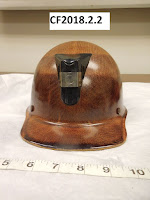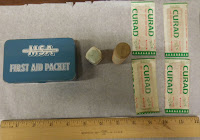So we are on Week 4 of Trails of History sites closed to the public. All onsite public activities and all onsite events are canceled through April 30. Staff are either on site performing maintenance and security duties--thank you to these essential workers--or teleworking on projects to keep services and communications going and plan for our eventual reopening. To see what your favorite sites are sharing on social media, check the April program page for links to Facebook. To see some recent highlights, check out last week's post. And if you're looking for videos to watch, PHMC's YouTube channel has all kinds of options.
For up-to-date information on Pennsylvania's response to COVID-19, please visit the Pennsylvania Dept. of Health website. Also, you may want to read info about increasing concerns about scams related to economic stimulus payments.
This week's post comes to us from Bureau of Historic Sites and Museums curator Rachel Yerger (see her March 27 post on Hope Lodge collections), with a focus on mining personal protective equipment (PPE) in the collection at Cornwall Iron Furnace. Cornwall site administrator Mike Emery provided additional images for the post. To see other mining-related collections, visit PHMC's new Museum Collections online portal and select Anthracite Heritage Museum, Cornwall Iron Furnace, or Eckley Miners' Village on the PHMC Museums tab.
UPDATE 4/20/2020: Rich Hall, a docent at Erie Maritime Museum and a retired design engineer for General Electric, shared some info on Personal Protective Equipment [sorry, we're having trouble with that link] and a Mine Monument in western PA that he presented at a meeting of the Western Mining Electrical Association. Rich also made a presentation on the Erie Maritime Museum, which is housed in a former Penelec electrical generating plant (some of Rich's EMM projects have been reported on in Trailheads posts in 2014 and 2015).
What is PPE? I’m sure by now many have heard the acronym and know that it stands for Personal Protective Equipment. But PPE means something different for a miner than it does for a medical professional. Against the harsh underground conditions faced by miners, thin nitrile or latex gloves just won’t cut it. This week I thought I would highlight some PPE used in the Cornwall Iron Mines during the mid-late 20th Century.
Cornwall is home to one of the most important iron-ore mines in Pennsylvania history. Ore mining was the backbone of the Cornwall Iron Furnace, which produced iron from 1742 until 1883. Even when the furnace ceased production, the mines continued to operate under the helm of Bethlehem Steel until 1973 when the mines were closed due to extensive flooding from Hurricane Agnes.
 |
| November 1963 National Safety Council Poster, posted by Cornwall Mine #4, Cornwall, PA. (Photo from the Charlie Neal research collection, Cornwall Iron Furnace. ) |
Mine safety became an industry priority in the United States around the turn of the 20th Century. As with many other industry safety regulations, it took a wave of mining disasters to reform industry safety standards. The
U.S. Bureau of Mines was formed in 1910 and while their mission has evolved over the years, their main goal has been safety. Around the same time
Mine Safety Appliances Inc. (MSA Inc.), a Pittsburgh-based company, was founded by John T. Ryan Sr. and George H. Deike.
 |
| CF2018.2.2 Miner’s Safety Helmet. This miner’s helmet, made by Mine Safety Appliances Inc., was used by Francis Boughter while working at Cornwall Ore Mine, Lebanon, PA. Mr. Boughter worked in Cornwall mines until it was shut down in 1973. (Learn more about this object in PHMC's Museum Collections portal.) |
One of the first products MSA Inc. made was an electric cap lamp. Prior to electric cap lamps, miners used flame-based light sources, like carbides or oil lamps, which created considerable safety hazards in mines. Not only were electric cap lamps a massive safety enhancement, but they also improved visibility, which increased productivity.
 |
| CF2018.1.10 Edison Model S Electric Cap Lamp. This cap lamp was used by William J. Fritz while working as a Concreter and Timberman in the #3 and #4 underground mines at Cornwall, Lebanon, PA. (View in Collections portal) |
 |
| Men working in Cornwall Mine, 1946. (Photo from the Charlie Neal research collection, Cornwall Iron Furnace.) |
Over the years MSA Inc.’s product offerings grew to include all types of personal safety items, such as pocket-sized first aid kits.
 |
| CF2108.1.6A-G MSA First Aid Packet. In addition to PPE MSA also produced this first aid kit which includes Merthiolate tincture, mercury-containing antiseptic, now banned in over-the-counter products by the FDA. (View in Collections portal) |
Effective check-in and check-out systems are also cornerstones of mine safety. At Cornwall Mine, as with other mines, each miner was assigned two brass tags with an individual identification number. The miner would leave their tag on the tagboard before entering the mine, and then remove it once they returned to the surface. This was an important way to ensure that every worker was accounted for.
 |
| CF2018.1.21A-B Brass Check Tag 3942, William Fritz. These tags were used by William Fritz. According to another Cornwall Mineworker, the brass tags could also be used to sign out equipment and collect paychecks. |
Personal safety and the use of personal protective equipment while on the job is a priority, regardless of the industry. Current shortages in PPE for medical professionals are a real problem in many states. Sadly, none of the PPE in the Cornwall Iron Furnace collection qualify as PPE for medical professionals under CDC guidelines, but we are pulling together some of our curatorial PPE, which does qualify, to donate to state agencies that are currently in need.
What can you do to help?









0 comments:
Post a Comment